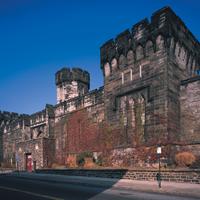
Jul 10, 2014
In our Morality show, we tell the story of Eastern State Penitentiary -- a radical new kind of prison engineered to crack into the hearts and minds of 19th-Century criminals, and make them feel true remorse.
It didn't work. The prison, and the ideals that gave rise to its strange new layout and inner workings, were eventually abandoned. The once-state-of-the-art building now looks like an ancient ruin. (What's left has been turned into a museum in Philadelphia). Here are some photos of how it looks now, plus a few shots taken in its heyday. (Listen to the story at the top of this post for more details, or listen to the full Morality episode.)
The exterior of Eastern State Penitentiary was built to intimidate. Its cold-sweat-inducing Gothic facade was meant, as its Board of Commissioners put it in 1822, to "convey to the mind the misery which awaits the unhappy being who enters within its walls.”
But inside was a different story. Instead of a gloomy dungeon, visitors were startled by its church-like beauty.
With soaring ceilings and over 1,000 skylights, Eastern State's airy architecture grew out of equally lofty ideals. Architect John Haviland created a setting meant at every turn to drive a spiritual transformation. He imagined "a forced monastery, a machine for reform," as Eastern State's website puts it.
But prisoners weren't exalting in all this space. Underpinning the logic of the entire operation was one key tenant: solitude.
... the proponents of the system believed strongly that the criminals, exposed, in silence, to thoughts of their behavior and the ugliness of their crimes, would become genuinely penitent. Thus the new word, penitentiary.¹
This meant that inmates did their time at Eastern State in solitary confinement, very rarely leaving their cells. Not even for meals. Their food was delivered by carts that ran on tracks through the barrel-vaulted corridors.
And even if an inmate was fortunate enough to get a break from his cell, it probably wasn't much relief:
The early system was strict. To prevent distraction, knowledge of the building, and even mild interaction with guards, inmates were hooded whenever they were outside their cells.²
The hoods also enforced a policy of anonymity -- so no inmate would ever see the face of another inmate.
Each prisoner's world was a high-ceilinged rectangle lit by a slit of a sky -- a narrow opening in the solid rock known as an "Eye of God" window.
Here's what the cells would have looked like in their prime (in the 1830s):
In case this strikes you as bare bones, consider this: every cell had central heat and a flush toilet. This was cutting-edge comfort. The White House didn't get running water, or its first "bathing house," until 1833.
But in spite of its relative luxury and its founders' good intentions, Eastern State came under criticism as an inherently cruel place, sparking debates about solitary confinement. And by 1913, the "Philadelphia System" forged at Eastern State was officially discontinued.
For more images and history, head to easternstate.org, where you can also plan a trip to the penitentiary.
And one last photo for fun...








